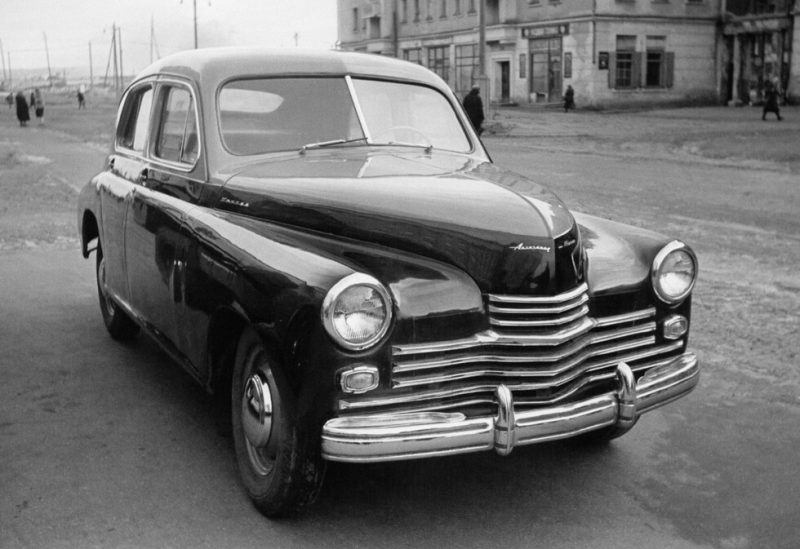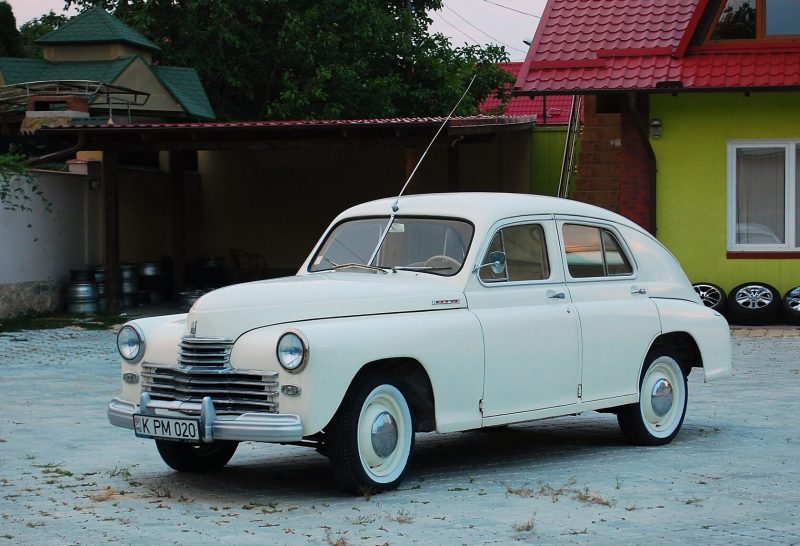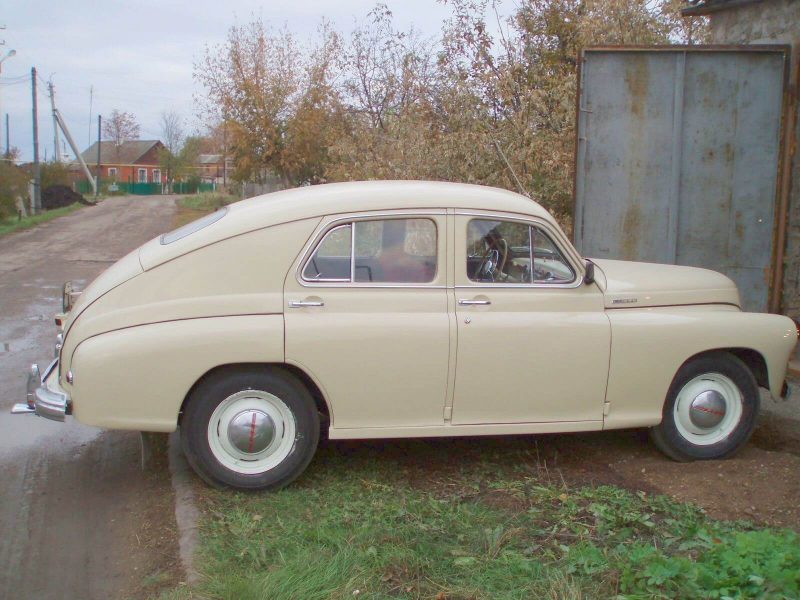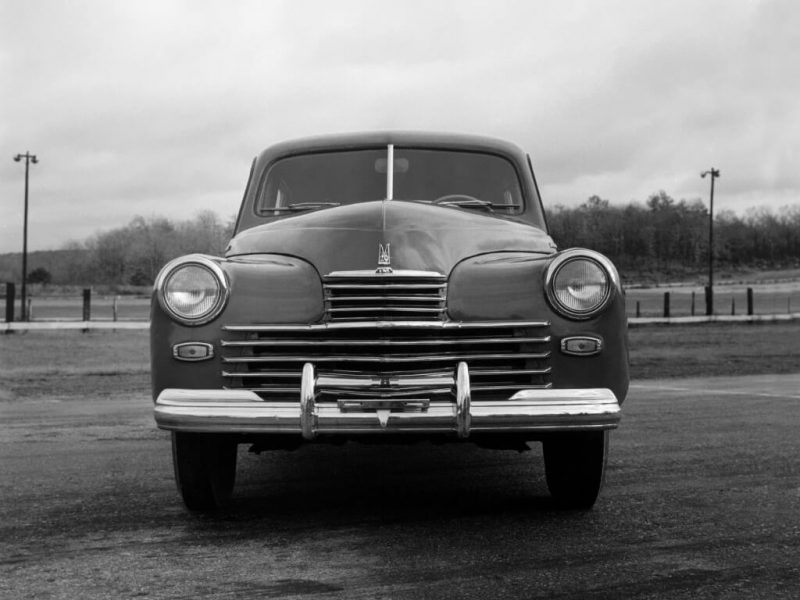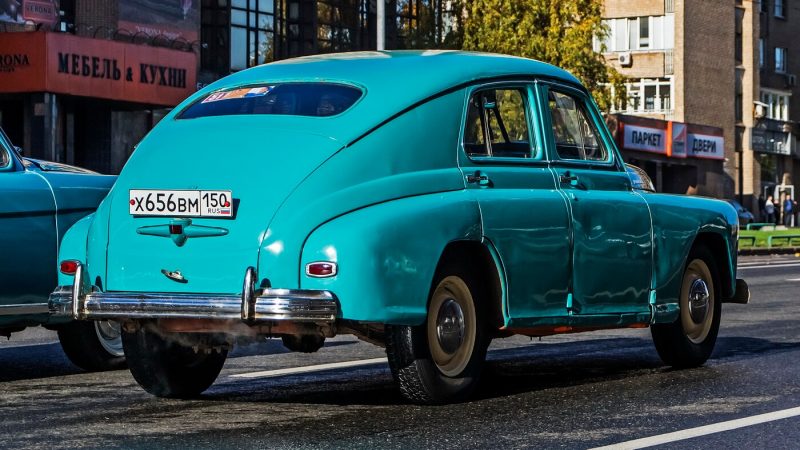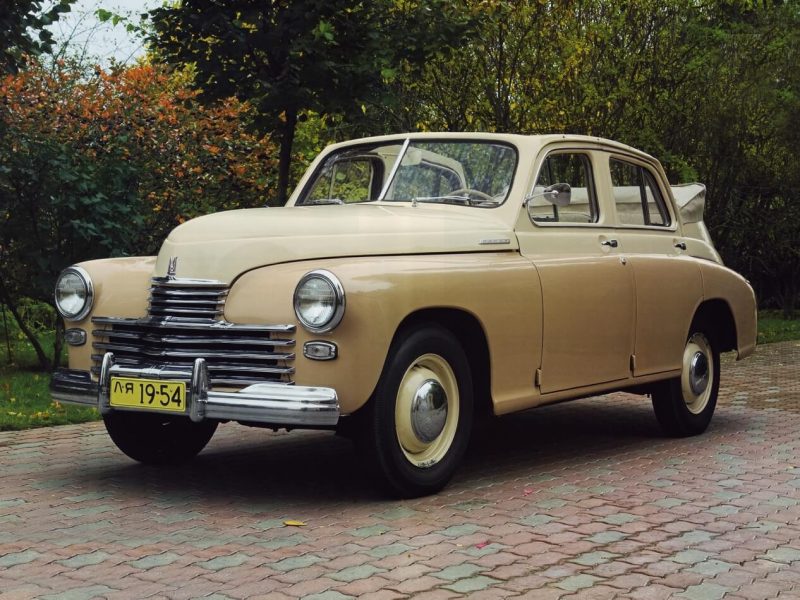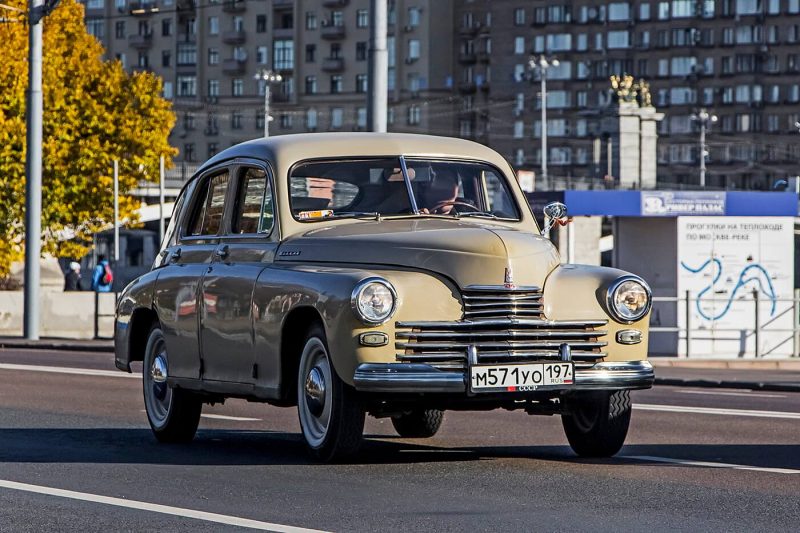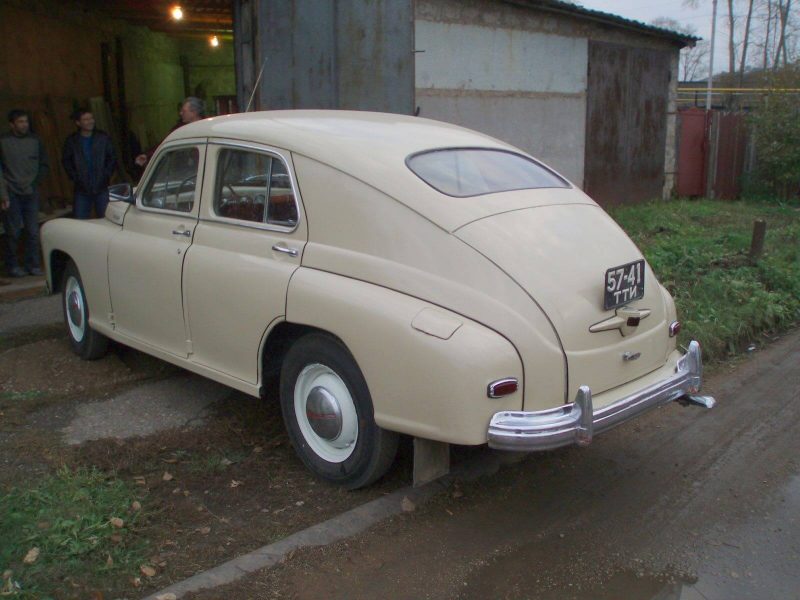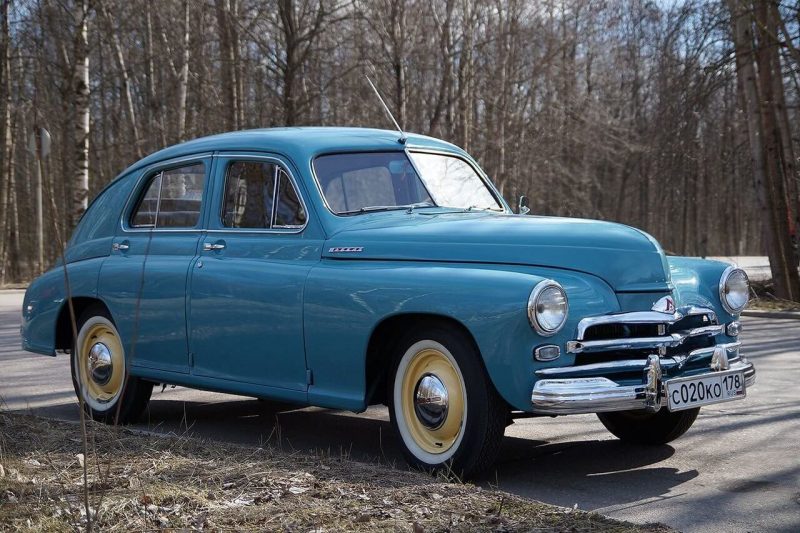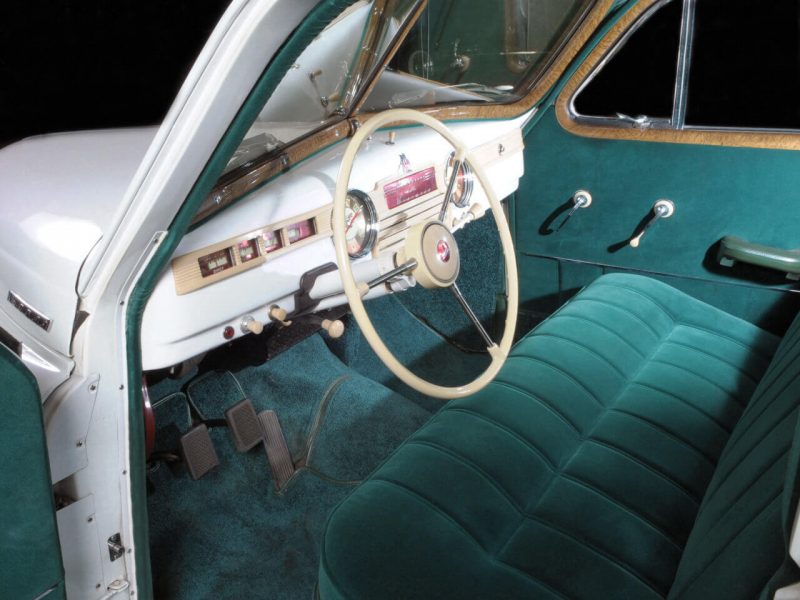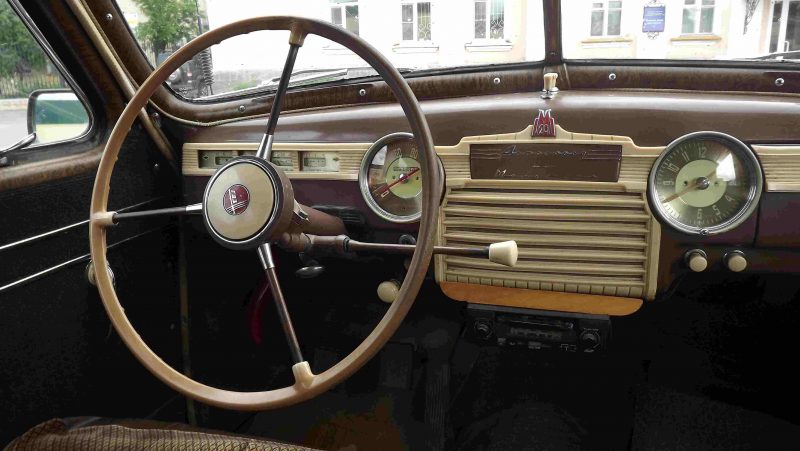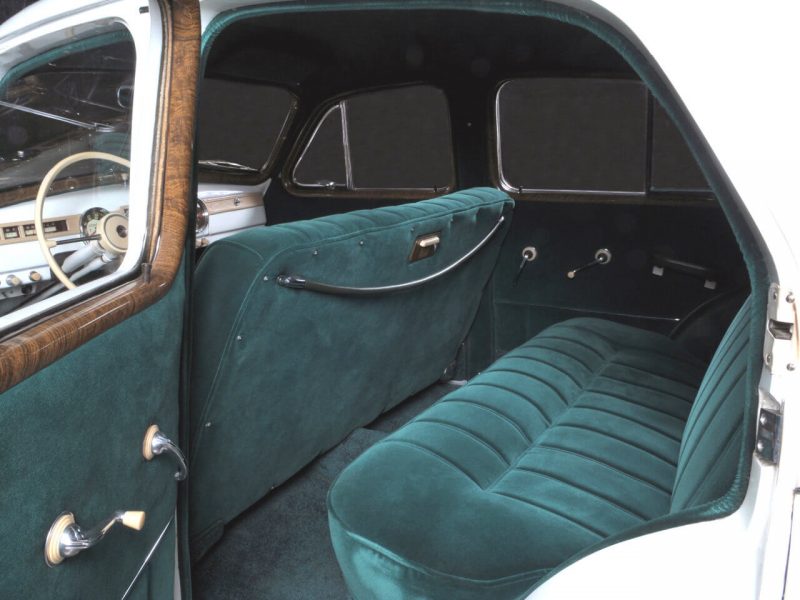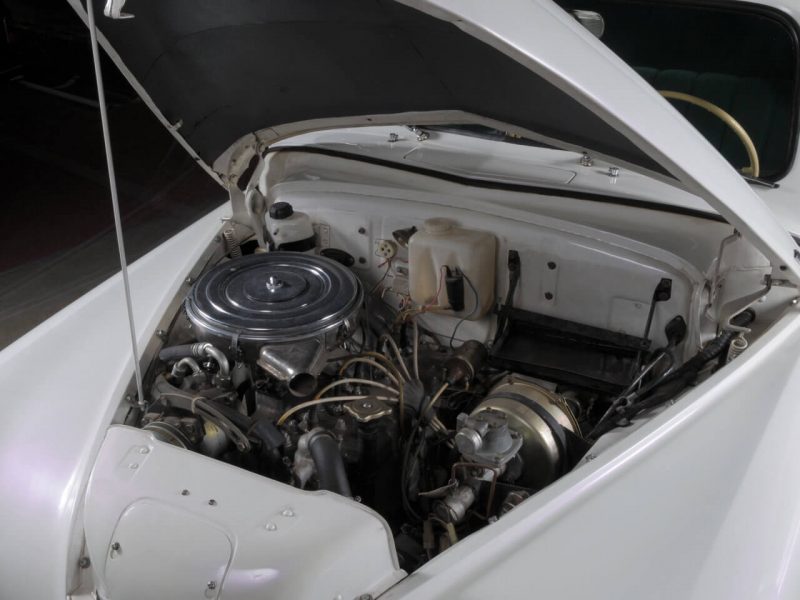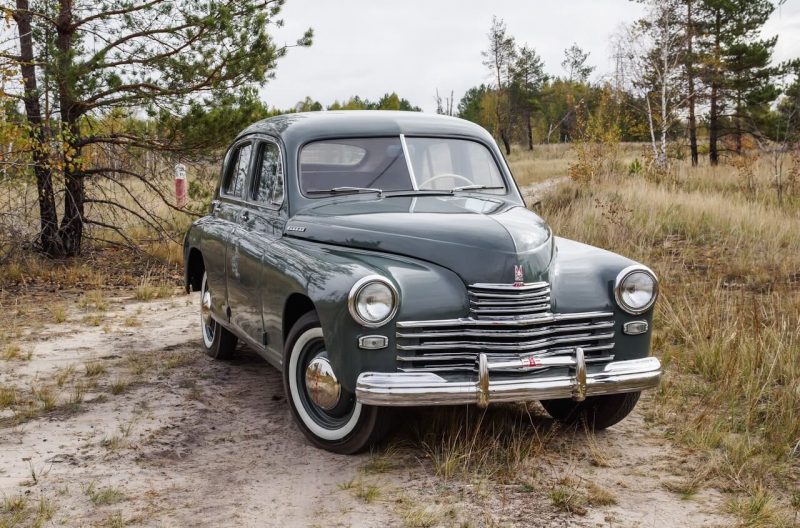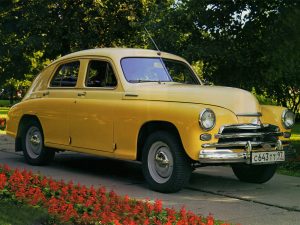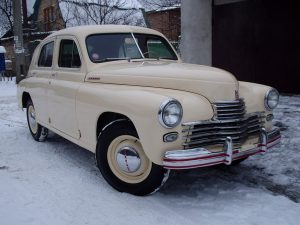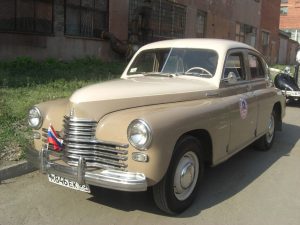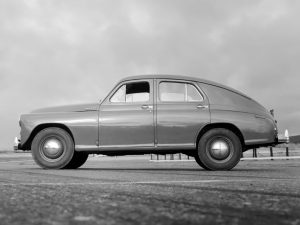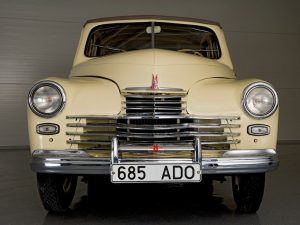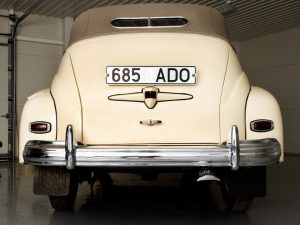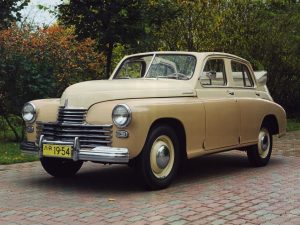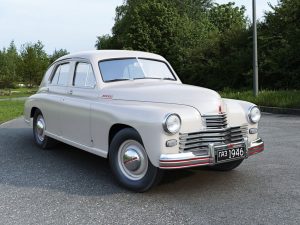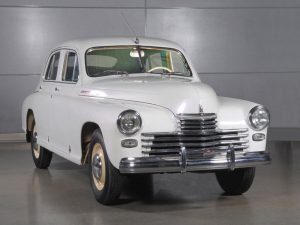GAZ-M20 Pobeda
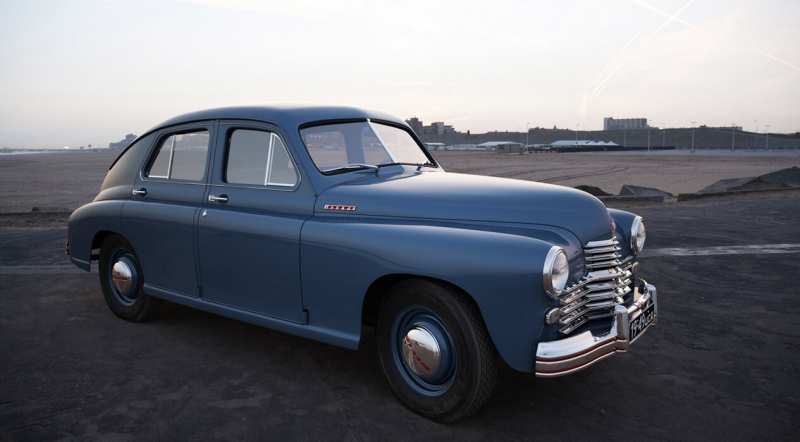
GAZ-M20 Pobeda is a serial car produced by the Soviet state. Production was carried out by the Gorky Automobile Plant from 1946 to 1958. The model was one of the world’s debut mass-produced cars with a 4-door pontoon-type body, which had no separate wings, steps and headlights. It was produced in different modifications, which can include an open body such as “convertible”. The whole model range is GAZ.
Car history
The car was not just called a Pobeda because it was actually a victory in all relationships. The Soviet army was able to win the Great Patriotic War, there were opportunities to raise the country’s industry to a high level. Therefore, the new model was able to become a symbol of those times.
The design of the new vehicle showed that there is a great potential in the industry of the USSR, and it is able to produce products that would not be inferior in their technical characteristics to the popular foreign manufacturers.
We can add the fact that almost immediately after the end of the hostilities, the production of GAZ-M20 was launched, which is a significant achievement. During the Soviet times, all the most important things were done on behalf of the party.
Therefore, as soon as the war came to an end, in 1945 the task came to the design bureau from the government – to design a machine for civilian purposes. Many enterprises of the Union of Soviet Socialist Republics, together with the industry as a whole, were focused on the production of military vehicles, and the party leadership was already looking to the future.
In the past difficult years, it has been difficult to imagine the full scope of the work of fulfilling orders. The task was to build a passenger car that would be accessible, reliable and affordable for a well-off citizen of the Soviet Union.
As a result, GAZ-M20 Pobeda was the car of creative intellectuals, military officials and other honored persons of the USSR. The design of the new vehicle was carried out by the famous designer Andrey Alexandrovich Lipgart. At the time, he had an internship at Ford’s Detroit plant. However, the car had nothing to do with his experience of the “American plan”. This was a completely unique car, which was designed by Andrey Lipgart.
Following the end of the fighting, a new GAZ automobile plant was started to be built in Gorky. The designer himself also took part in its construction, and after that he was able to head its design bureau for car design. The car he designed was actually unique. It was the first car with a “pontoon-type” body, which was produced in the USSR.
If you look at the model from the side of aerodynamic parameters, Andrei Alexandrovich has thought of the body so that he can even today earn high marks. The first column of several GAZ M 20 Pobeda vehicles was sent from the Gorky Automobile Plant to Moscow to view the state commission. However, the first acquaintance allowed the commission to reject the car. Party leaders and generals did not like the fact that during the landing in the car the pope flew off the head of the military.
In general, they considered the model to be still “damp”, so they gave it another year for improvement. In one year they were able to make a list of improvements at the plant. For example, the sofa installed at the back was lowered extremely low. Some improvements to the design plan could even be called advanced – because it was in GAZ-M20 Victory that the presence of a stove appeared, which allowed customers to move without thick clothes and warm shoes.
In addition, a radio receiver was installed on the model. Even judging by the body shape, it was a real breakthrough at the time. The body was streamlined, elegant and even slightly feminine, which corresponded to the trends in car fashion.
Under the leadership of Andrei Lipgart, he managed to design a truly amazing, original and modern car that stood out from the crowd.
From the very beginning they wanted to give the car the name “Motherland”, which, according to the idea, was suitable for the commission. However, Stalin asked: – And why will we sell the “Motherland”? This put many people at a standstill, so we decided to choose the name “Victory”, which symbolized the victory of the Soviet soldiers over the Nazi Germany.
In total, about 236,000 vehicles were able to produce, and many of them survived even to this day, due to the fact that Andrey Alexandrovich managed to make the design, on the one hand, reliable and durable, and on the other – simple and maintainable.
The knots, along with the Victory units, were perfectly synchronized with other spare parts of the cars, so it was not in vain that in order to repair it, you need Russian ingenuity, “hammer with a chisel” and “a few hot words”. There were cases when the car was turned over several times, then got up on wheels, and as if nothing happened, continued to go. All this eloquently testified to the good body strength.
During its years of life, GAZ-M20 has changed its appearance several times, went through what is commonly known as “restyling”, which corresponded to the trends in car fashion. Moreover, the car had various modifications.
So, besides the standard “sedan”, there was a version of the convertible (which was an unheard of luxury for the residents of the Soviet Union), which was designed for comfortable rest. There were orders for cars on the basis of GAZ-M20 Pobeda, which were intended for the villages, so the specialists of the Gorky Automobile Plant were even able to make a four-wheel drive version of the sedan.
This allowed the chairmen of large collective and state farms to travel around their own fields with dignity and without fear of being stuck somewhere in the field. They even tried to build an ambulance from the model, but nothing happened because the body was too short. And here the model has received the popularity in the Moscow taxi. Also, it will not be superfluous to say that just at GAZ-M20 Victory for the first time was lit by the famous green light in the upper corner of the glass, which indicated that the taxi is free.
The clever suspension allowed GAZ-M20 to have victory while driving smoothly, than other cars could not boast. Not every citizen could have bought a Gorky car, but despite this, the first Victory Shop was located in Moscow, near Baumanskaya. In order to buy it, the queue began to line up, despite, to put it mildly, not very democratically.
All cars were missing, so “Victory” was decided to make, in a sense, a bargaining chip. Therefore, it could be issued as a reward and awards for famous people, which could include artists, professors, academics and military pilots. To date, the machine has become a retro model, which is quite affordable. For quite a small amount of money there is a possibility to buy a good enough car with a decent technical condition. In addition, it has excellent maintainability, so it will fit a large number of parts from other cars.
For example, a power unit from the 24th Volga will feel quite cozy in Victory. The first exhibition of the Soviet Union, where the country presented its own car, allowed to cause a general sensation. The grandson of the famous Henry Ford, from whom Lipgart studied, when examining the car, he was able to frankly admit that in this case, the student surpassed the teacher – because he really liked it.
After GAZ-M20 was able to win the success of the international plan, it began to be copied, even England could not resist such a temptation. It began to be produced in the UK under the name of Longard Standard. It was very similar to Pobeda, and all its technical solutions were there. After the model in the Soviet Union was removed from serial production at the Gorky plant, the rights to its production were decided to sell to Poland, which for 20 years has been producing this machine under the label “Warsaw”.
But everybody understands that the years go by and the world system of the automotive industry began to take big steps to improve, so GAZ-M20 very soon began to become morally obsolete. Inactivity of the Russian automotive industry did not allow further improvement of this car.
Serial production replaced the Pobeda with the 21st Volga, so GAZ-M20 went on to the secondary plan. The design staff had promising developments, ideas, innovations, but all this was dissolved in the offices of politicians. If these barriers hadn’t been present, we would have had a fundamentally new car industry, which would have had a higher level.
But despite all this, there are a lot of connoisseurs of such a legendary car all over the world, as well as in the Russian Federation. There are even specialized clubs in Germany, in Eastern Europe, where fans of such a brand are gathered. The Russian Federation has GAZ-M20 amateur clubs, which often travel to the annual routes on April 12 and May 9.
Exterior
Until the mid-40s, Pobeda was a revolutionary machine. The design of the load-bearing body, which was borrowed from the Opel Kapitan 1938, allowed GAZ’s design staff to fully rethink the appearance of the car and to adopt a list of innovations that were spread in the west only after a few years.
If we talk about the GAZ-M20 body, it can be referred to as a rare today’s “fastback” type. It is an aerodynamic “two-volume” vehicle, where there is a sloping roof, narrowed rear part, strongly inclined rear window and a dedicated luggage compartment with a small capacity.
The Opel’s prototype had 4 doors, where the front doors opened in the course of the car’s movement, while the rear doors opened against it. The appearance of the Pobeda was pleasant, partly due to the appearance of the waist line, the combination of front and rear wings with the body, the absence of decorative steps, the alligator hood, the headlights integrated in the nose and other characteristic elements that were unusual in those years.
Interior
Inside the Soviet sedan there was a lot of space, and the car had a good capacity. The driver sat down and got maximum (at that time) comfort and convenience. Perhaps, the sofa installed in front of the sofa was influenced by the fashion of the Americans, which was watched personally by the designer, but it was possible to stretch out comfortably along the entire length in order to rest during the break, and may even stay overnight, if necessary.
The steering wheel today is not very comfortable, is quite thin and has a huge size – although all this used to be in the fashion of those times. Interestingly enough, the Pobeda gearbox was installed in the same place as the American models – there was a control lever, which was located under the steering wheel.
The employees of the Gorky Automobile Plant also installed wipers and a couple of switches for them (depending on the rain force). The front panel has more informative devices, you can also observe the setting of the clock, which does not interfere with the overall interior.
All the sensors on the dashboard were arranged in symmetrical order, which also, at least indirectly, indicates the fashion of the time. The interior was decorated with plastic, which imitated wooden divorces, and armchairs were covered with leatherette, in rare cases used velour.
If we talk about visibility, it suffered a lot, but do not forget that in those years, there were not so many cars, on this basis, there was no need to install a rear view mirror. Vehicle doors have windows, and the windows could be raised and lowered manually, they were enclosed in tight frames to avoid rattling.
As mentioned above, the sedan was used successfully under the taxi, so the sofa installed at the back was quite spacious for passengers with any equipment. Those who like to smoke will be able to use the built-in ashtray in the back of the sofa installed in front. In order to ensure good ventilation of the cabin, the rear doors also received the presence of vents.
The luggage compartment of GAZ-M20 Pobeda was not distinguished by its spacious qualities, because the lion’s share was taken away for spare parts and a box of tools. But still, some suitcases were put in the trunk. Smart drivers sometimes attached a luggage compartment on the roof to the body, on which they managed to carry garden tools to the country house and so on.
Specifications
Powertrain
From the very beginning the power unit with the lower valve position should have been a 6-cylinder one, but Andrey Alexandrovich decided to take the initiative to create a four-cylinder model.
Just such an engine was more economical and, most importantly, was a “people’s engine” with a factory index GAZ-20 (literature “M” spoke about the common name “hammer man”).
The engine was approved for serial production at the review of the top party leadership in 1945. A little later, the 6-cylinder machine, however, began to be produced in small series under the name M-20G/M-26, but there was a fundamentally different power unit. It was an engine from Winter (GAZ-23), which produced 90 horsepower.
The main engine is the famous four-cylinder 2.1-liter engine, which produces about 50 horses. The predecessor engine, Emki, also had this power, but its engine had a volume of 3.5 litres and a much modest fuel consumption.
GAZ-M20 consumes about 10-11 liters per hundred kilometers, but GAZ-M1 already consumes about 13 liters. The first hundred kilometers of sedan gained in a long 45 seconds, and the maximum speed reaches 105 kilometers per hour.
Transmission
The original version of GAZ-M20, which was produced in series from the 46th to 48th years, had a three-stage unsynchronized manual gearbox from the car GAZ-M1, where there was a clutch “easy inclusion” (instead of synchronizer).
Since the early 1950s, GAZ-M20 had a 3-speed gearbox, where there were synchronized 2nd and 3rd gears, from the GAZ-12 “Winter” car. A little later, this box passed to the 21st Volga. The gear lever was moved from the floor to the steering column.
Suspension
The independent suspension of the lever-spring type was in front of it. Everything was much easier in the back, there were springs. The shock absorbers were double-acting hydraulic. They allowed the machine to run smoothly. The basic scheme of the front suspension was later used on all models of the “Volga”.
It had a pin type and threaded bushings. Some parts were borrowed from the Opel, but the kingpin device itself had its own design. Hydraulic shock absorbers had a lever method of operation, which allowed them to be, at the same time, the upper arms of the suspension.
Brake system
It was considered the most perfect in the middle of the 20th century. After all, it was a hydraulic braking system at Pobeda, previously this type of braking system was not used in the secular automotive industry. However, there was only one circuit, no separation. It turns out that if one of the 4 cylinders leaked, the brakes disappeared all.
All the Volga models with drum brakes had a pair of working cylinders per wheel on the front suspension. The Pobeda had one cylinder on the two pendants, and each of them had a pair of pads at the same time.
Modifications
Generally speaking, the Pobeda did not have so many modifications. During the twenty-year period of production, it was only twice subject to modernization, and all machines were conditionally divided into 3 series:
- GAZ M20. It was a standard car of the 1st and 2nd series. The first (from 1946 to 1948) was produced in small quantities, and in serial terms had a lot of defects. In some period, even suspended production of the car, but starting from the 49th year, started the 2nd production of GAZ M20, which ended only in 1954;
- GAZ M20B. The 3rd series of cars, which started in 1955 and was completed along with the completion of production of GAZ Pobeda in general. The machine had a changed radiator grille and radio receiver;
- GAZ M20A. The vehicle was intended for work under a taxi. The car was produced since 1949 (from the 2nd series). The total number of vehicles produced was more than 37 000 units;
- GAZ M20 “Kabriolet”. The car, where there was an open top (there was no metal roof). Its production was established from 1949 to 1953. A total of about 14,000 copies were produced.
Small batches of Pobeda were also produced for the security services. We designed a super-cabriolet to hold military parades. Even the sports modifications were, however, produced in a small number of copies.
The pros and cons
Pluses cars
- A quality bodywork;
- Hydraulic braking system;
- Small cost and ease of interchangeability of elements and details;
- Pleasant appearance;
- High ground clearance (200 mm);
- Spacious and convenient interior;
- Presence of soft sofas in front and behind;
- Radio;
- Soft suspension, allowing the sedan to move smoothly;
- Rich history;
- Convenient steering shift gearbox.
Cons of a car
- Weak power pack;
- Low fuel consumption;
- Only two brake cylinders per suspension;
- Low weight of the machine;
- No hydraulic power steering;
- Unreliable brakes;
- No seat belts;
- Small luggage compartment;
- Low dynamic characteristics;
- Under a hood a lot of free unnecessary space.
We sum up
Few people who do not know about such a great car of the Soviet Union as GAZ-M20 Pobeda. Its appearance, in fact, can be called a victory, because the sedan has become a real breakthrough. And it concerned not only external characteristics. Although the Soviet people have never seen anything like this before. The car began to enjoy such a demand that it was simply not enough for everyone. And, it should not be forgotten that it also cost not cheaply, but it did not greatly affect its popularization. Therefore, this model was given out for certain merits and as gifts. The body of the car was really new and fresh.
He allowed to compete even with western variations of machines due to the fact that Andrey Alexandrovich (leading designer) was engaged in its design. And he himself was trained “not somewhere there”, and in England, which may have influenced the creation of this vehicle. It is clear that inside the vehicle the level of comfort and convenience is not as high as that of today’s cars, but for those times it was a real breakthrough. There was plenty of free space inside the Pobeda, so all future Volga, which were produced at the Gorky Automobile Plant, still have this pleasant advantage.
Of course, the capacity was obviously not enough, and acceleration up to 100 kilometers took about 45 seconds, but GAZ-M20 was not a racing car, so he coped well with his direct duties. Even today, after more than a dozen years, you can meet this model, which serves as a sign that the Russian army in Soviet times was able to gain a significant victory over the Nazis. Moreover, there are many examples of model improvements on the Internet today, GAZ 20 Pobeda Tuning.
We advise you to read the article: GAS – history of car production.


